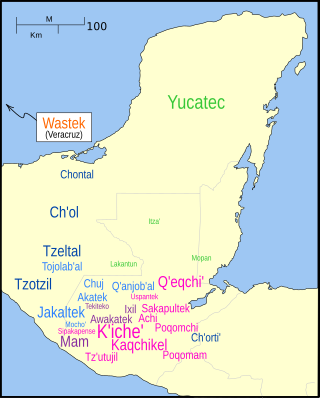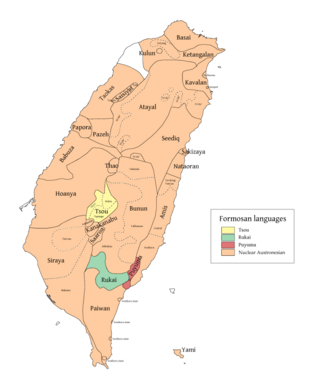Related Research Articles

Madí—also known as Jamamadí after one of its dialects, and also Kapaná or Kanamanti (Canamanti)—is an Arawan language spoken by about 1,000 Jamamadi, Banawá, and Jarawara people scattered over Amazonas, Brazil.

Tzeltal or Tseltal is a Mayan language spoken in the Mexican state of Chiapas, mostly in the municipalities of Ocosingo, Altamirano, Huixtán, Tenejapa, Yajalón, Chanal, Sitalá, Amatenango del Valle, Socoltenango, Las Rosas, Chilón, San Juan Cancuc, San Cristóbal de las Casas and Oxchuc. Tzeltal is one of many Mayan languages spoken near this eastern region of Chiapas, including Tzotzil, Chʼol, and Tojolabʼal, among others. There is also a small Tzeltal diaspora in other parts of Mexico and the United States, primarily as a result of unfavorable economic conditions in Chiapas.
Rapa Nui or Rapanui, also known as Pascuan or Pascuense, is an Eastern Polynesian language of the Austronesian language family. It is spoken on Easter Island, also known as Rapa Nui.
The Nafsan language, also known as South Efate or Erakor, is a Southern Oceanic language spoken on the island of Efate in central Vanuatu. As of 2005, there are approximately 6,000 speakers who live in coastal villages from Pango to Eton. The language's grammar has been studied by Nick Thieberger, who has produced a book of stories and a dictionary of the language.
Kambera, also known as East Sumbanese, is a Malayo-Polynesian language spoken in the eastern half of Sumba Island in the Lesser Sunda Islands, Indonesia. Kambera is a member of Bima-Sumba subgrouping within Central Malayo-Polynesian inside Malayo-Polynesian. The island of Sumba, located in Eastern Indonesia, has an area of 11,243.78 km2. The name Kambera comes from a traditional region which is close to the town of Waingapu in East Sumba Regency. Because of export trades which concentrated in Waingapu in the 19th century, the language of the Kambera region has become the bridging language in eastern Sumba.
Seediq, also known as Sediq, Taroko, is an Atayalic language spoken in the mountains of Northern Taiwan by the Seediq and Taroko people.

East Ambae is an Oceanic language spoken on Ambae, Vanuatu. The data in this article will concern itself with the Lolovoli dialect of the North-East Ambae language.

Tsou is an Austronesian language spoken by the Tsou people of Taiwan. Tsou is a threatened language; however, this status is uncertain. Its speakers are located in the west-central mountains southeast of the Chiayi/Alishan area in Taiwan.
Canela is a dialect of the Canela-Krahô language, a Timbira variety of the Northern Jê language group spoken by the Apànjêkra (Apaniêkrá) and by the Mẽmõrtũmre in Maranhão, Brazil.
Southern Oromo, or Borana, is a variety of Oromo spoken in southern Ethiopia and northern Kenya by the Borana people. Günther Schlee also notes that it is the native language of a number of related peoples, such as the Sakuye.

Karo, referred to in Indonesia as Bahasa Karo, is an Austronesian language that is spoken by the Karo people of Indonesia. It is used by around 600,000 people in North Sumatra. It is mainly spoken in Karo Regency, southern parts of Deli Serdang Regency and northern parts of Dairi Regency, North Sumatra, Indonesia. It was historically written using the Batak alphabet which is descended from the Brahmi script of ancient India by way of the Pallava and Old Kawi scripts, but nowadays only a tiny number of Karo can write or understand the script, and instead the Latin script is used.
Paamese, or Paama, is the language of the island of Paama in Northern Vanuatu. There is no indigenous term for the language; however linguists have adopted the term Paamese to refer to it. Both a grammar and a dictionary of Paamese have been produced by Terry Crowley.

The Sama–Bajaw languages are a well-established group of languages spoken by the Sama-Bajau peoples of the Philippines, Indonesia, and Malaysia.
Maia is a Papuan language spoken in the Madang Province of Papua New Guinea, and is a member of the Trans-New Guinea language family. It has a language endangerment status of 6a, which means that it is a vigorous and sustainable language spoken by all generations. According to a 2000 census, there are approximately 4,500 living speakers of the language, who are split between twenty-two villages in the Almani district of the Bogia sub-district.
Bandial (Banjaal), or Eegima (Eegimaa), is a Jola language of the Casamance region of Senegal. The three dialects, Affiniam, Bandial proper, and Elun are divergent, on the border between dialects and distinct languages.
Mekeo is a language spoken in Papua New Guinea and had 19,000 speakers in 2003. It is an Oceanic language of the Papuan Tip Linkage. The two major villages that the language is spoken in are located in the Central Province of Papua New Guinea. These are named Ongofoina and Inauaisa. The language is also broken up into four dialects: East Mekeo ; Northwest Mekeo ; West Mekeo and North Mekeo. The standard dialect is East Mekeo. This main dialect is addressed throughout the article. In addition, there are at least two Mekeo-based pidgins.
Tawala is an Oceanic language of the Milne Bay Province, Papua New Guinea. It is spoken by 20,000 people who live in hamlets and small villages on the East Cape peninsula, on the shores of Milne Bay and on areas of the islands of Sideia and Basilaki. There are approximately 40 main centres of population each speaking the same dialect, although through the process of colonisation some centres have gained more prominence than others.
Mori Bawah, also known as Lower Mori or East Mori, is an Austronesian language of the Celebic branch. It is one of the principal languages of the Morowali Regency in Central Sulawesi.
Mày is a Vietic language spoken by the May people of Minh Hóa district, Quảng Bình province, Central Vietnam. It is a member of the Cheut language cluster, which belongs to the Vietic branch of the Austroasiatic family. With only several hundred speakers, May is a critically endangered language, with only about half of the estimated ethnic population of 1,228 people able to speak the language.
Neverver (Nevwervwer), also known as Lingarak, is an Oceanic language. Neverver is spoken in Malampa Province, in central Malekula, Vanuatu. The names of the villages on Malekula Island where Neverver is spoken are Lingarakh and Limap.
References
- ↑ Belait at Ethnologue (16th ed., 2009)

- 1 2 Martin, Peter W. 1995. 'Whither the indigenous languages of Brunei Darussalam?' Oceanic Linguistics 34:44–60
- ↑ Blust, Robert. 1997. 'Ablaut in Western Borneo'. Diachronica XIV:1–30.
- 1 2 3 4 5 6 7 8 9 10 11 12 Clynes, Adrian. 2005. 'Belait'. In Nikolaus P. Himmelmann & Alexander Adelaar (eds.) The Austronesian Languages of Asia and Madagascar. Abingdon: Routledge.
- ↑ Martin, Peter W. 1990. Notes on the Phonology of Belait. Unpublished MS.
- ↑ Noor Alifah Abdullah. 1992. Struktur bahasa Belait. Unpublished BA Thesis, Department of Malay Language and Linguistics, Universiti Brunei Darussalam.